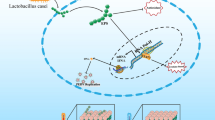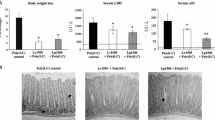Abstract
The protein 3D8 single-chain variable fragment (3D8 scFv) has potential anti-viral activity due to its ability to penetrate into cells and hydrolyze nucleic acids. Probiotic Lactobacillus paracasei engineered to secrete 3D8 scFv for oral administration was used to test the anti-viral effects of 3D8 scFv against gastrointestinal virus infections. We found that injection of 3D8 scFv into the intestinal lumen resulted in the penetration of 3D8 scFv into the intestinal villi and lamina propria. 3D8 scFv secreted from engineered L. paracasei retained its cell-penetrating and nucleic acid-hydrolyzing activities, which were previously shown with 3D8 scFv expressed in Escherichia coli. Pretreatment of RAW264.7 cells with 3D8 scFv purified from L. paracasei prevented apoptosis induction by murine norovirus infection and decreased messenger RNA (mRNA) expression of the viral capsid protein VP1. In a mouse model, oral administration of the engineered L. paracasei prior to murine norovirus infection reduced the expression level of mRNA encoding viral polymerase. Taken together, these results suggest that L. paracasei secreting 3D8 scFv provides a basis for the development of ingestible anti-viral probiotics active against gastrointestinal viral infection.






Similar content being viewed by others
References
Arias A, Emmott E, Vashist S, Goodfellow I (2013) Progress towards the prevention and treatment of norovirus infections. Future Microbiol 8:1475–1487
Bok K, Prikhodko VG, Green KY, Sosnovtsev SV (2009) Apoptosis in murine norovirus-infected RAW264.7 cells is associated with downregulation of survivin. J Virol 83:3647
Botić T, Klingberg TD, Weingartl H, Cencič A (2007) A novel eukaryotic cell culture model to study antiviral activity of potential probiotic bacteria. Int J Food Microbiol 115:227–234
Duizer E, Schwab KJ, Neill FH, Atmar RL, Koopmans MP, Estes MK (2004) Laboratory efforts to cultivate noroviruses. J Gen Virol 85:79–87
Hamman JH, Enslin GM, Kotzé AF (2005) Oral delivery of peptide drugs: barriers and developments. BioDrugs 19:165–177
Hifumi E, Fujimoto N, Arakawa M, Saito E, Matsumoto S, Kobayashi N, Uda T (2013) Biochemical features of a catalytic antibody light chain, 22F6, prepared from human lymphocytes. J Biol Chem 288:19558–19568
Hsu CC, Wobus CE, Steffen EK, Riley LK, Livingston RS (2005) Development of a microsphere-based serologic multiplexed fluorescent immunoassay and a reverse transcriptase PCR assay to detect murine norovirus 1 infection in mice. Clin Diagn Lab Immunol 12:1145–1151
Jang JY, Jeong JG, Jun HR, Lee SC, Kim JS, Kim YS, Kwon MH (2009) A nucleic acid-hydrolyzing antibody penetrates into cells via caveolae-mediated endocytosis, localizes in the cytosol and exhibits cytotoxicity. Cell Mol Life Sci 66:1985–1997
Johnston C, Douarre PE, Soulimane T, Pletzer D, Weingart H, MacSharry J, Coffey A, Sleator RD, O'Mahony J (2013) Codon optimisation to improve expression of a Mycobacterium avium ssp. paratuberculosis-specific membrane-associated antigen by Lactobacillus salivarius. Pathog Dis 68:27–38
Jun HR, Pham CD, Lim SI, Lee SC, Kim YS, Park S, Kwon MH (2010) An RNA-hydrolyzing recombinant antibody exhibits an antiviral activity against classical swine fever virus. Biochem Biophys Res Commun 395:484–489
Karst SM, Wobus CE, Lay M, Davidson J, Virgin HW (2003) STAT1-dependent innate immunity to a Norwalk-like virus. Science 299:1575–1578
Kim YR, Kim JS, Lee SH, Lee WR, Sohn JN, Chung YC, Shim HK, Lee SC, Kwon MH, Kim YS (2006) Heavy and light chain variable single domains of an anti-DNA binding antibody hydrolyze both double- and single-stranded DNAs without sequence specificity. J Biol Chem 281:15287–15295
Kozyr AV, Sashchenko LP, Kolesnikov AV, Zelenova NA, Khaidukov SV, Ignatova AN, Bobik TV, Gabibov AG, Alekberova ZS, Suchkov SV, Gnuchev NV (2002) Anti-DNA autoantibodies reveal toxicity to tumor cell lines. Immunol Lett 80:41–47
Lee JS, Poo H, Han DP, Hong SP, Kim K, Cho MW, Kim E, Sung MH, Kim CJ (2006) Mucosal immunization with surface-displayed severe acute respiratory syndrome coronavirus spike protein on Lactobacillus casei induces neutralizing antibodies in mice. J Virol 80:4079–4087
Lee G, Yu J, Cho S, Byun SJ, Kim DH, Lee TK, Kwon MH, Lee S (2014) A nucleic-acid hydrolyzing single chain antibody confers resistance to DNA virus infection in hela cells and C57BL/6 mice. PLoS Pathog 10(6):e1004208
Maassen CB, van Holten-Neelen C, Balk F, den Bak-Glashouwer MJ, Leer RJ, Laman JD, Boersma WJ, Claassen E (2000) Strain-dependent induction of cytokine profiles in the gut by orally administered Lactobacillus strains. Vaccine 18:2613–2623
Martín MC, Alonso JC, Suárez JE, Alvarez MA (2000) Generation of food-grade recombinant lactic acid bacterium strains by site-specific recombination. Appl Environ Microbiol 66:2599–2604
McCartney SA, Thackray LB, Gitlin L, Gilfillan S, Virgin HW, Colonna M (2008) MDA-5 recognition of a MNV-1. PLoS Pathog 4:e1000108
Morishita M, Peppas NA (2006) Is the oral route possible for peptide and protein drugs delivery? Drug Discov Today 11:905–910
Mumphrey SM, Changotra H, Moore TN, Heimann-Nichols ER, Wobus CE, Reilly MJ, Moghadamfalahi M, Shukla D, Karst SM (2007) Murine norovirus 1 infection is associated with histopathological changes in immunocompetent hosts, but clinical disease is prevented by STAT1-dependent interferon responses. J Virol 81:3251–3263
Nakamura Y, Gojobori T, Ikemura T (2000) Codon usage tabulated from the international DNA sequence databases: status for the year 2000. Nucl Acids Res 28:292
Natori Y, Kano Y, Imamoto F (1990) Genetic transformation of Lactobacillus casei by electroporation. Biochimie 72:265–269
Oozeer R, Furet JP, Goupil-Feuillerat N, Anba J, Mengaud J, Corthier G (2005) Differential activities of four Lactobacillus casei promoters during bacterial transit through the gastrointestinal tracts of human-microbiota-associated mice. Appl Environ Microbiol 71:1356–1363
Pagnini C, Saeed R, Bamias G, Arseneau KO, Pizarro TT, Cominelli F (2010) Probiotics promote gut health through stimulation of epithelial innate immunity. Proc Natl Acad Sci U S A 107:454–459
Pant N, Hultberg A, Zhao Y, Svensson L, Pan-Hammarstrom Q, Johansen K, Pouwels PH, Ruggeri FM, Hermans P, Frenken L, Boren T, Marcotte H, Hammarstrom L (2006) Lactobacilli expressing variable domain of llama heavy-chain antibody fragments (lactobodies) confer protection against rotavirus-induced diarrhea. J Infect Dis 194:1580–1588
Perdigón G, Maldonado Galdeano C, Valdez JC, Medici M (2002) Interaction of lactic acid bacteria with the gut immune system. Eur J Clin Nutr 56(Suppl 4):S21–S26
Rao S, Hu S, McHugh L, Lueders K, Henry K, Zhao Q, Fekete RA, Kar S, Adhya S, Hamer DH (2005) Toward a live microbial microbicide for HIV: commensal bacteria secreting an HIV fusion inhibitor peptide. Proc Natl Acad Sci U S A 102:11993–11998
Rubio-del-Campo A, Coll-Marqués JM, Yebra MJ, Buesa J, Pérez-Martínez G, Monedero V, Rodríguez-Díaz J (2014) Noroviral p-particles as an in vitro model to assess the interactions of noroviruses with probiotics. PLoS One 9(2):e89586
Ruiz-Argüelles A, Rivadeneyra-Espinoza L, Alarcón-Segovia D (2003) Antibody penetration into living cells: pathogenic, preventive and immuno-therapeutic implications. Curr Pharm Des 9:1881–1887
Salminen S, Nybom S, Meriluoto J, Carmen Collado M, Vesterlund S, El-Nezami H (2010) Interaction of probiotics and pathogens-benefits to human health? Curr Opin Biotechnol 21:157–167
Sastalla I, Chim K, Cheung GY, Pomerantsev AP, Leppla SH (2009) Codon-optimized fluorescent proteins designed for expression in low-GC gram-positive bacteria. Appl Environ Microbiol 75:2099–2110
Schneider CA, Rasband WS, Eliceiri KW (2012) NIH Image to ImageJ: 25 years of image analysis. Nat Methods 9:671–675
Seegers JF (2002) Lactobacilli as live vaccine delivery vectors: progress and prospects. Trends Biotechnol 20:508–515
Shuster AM, Gololobov GV, Kvashuk OA, Bogomolova AE, Smirnov IV, Gabibov AG (1992) DNA hydrolyzing autoantibodies. Science 256:665–667
Steidler L, Neirynck S, Huyghebaert N, Snoeck V, Vermeire A, Goddeeris B, Cox E, Remon JP, Remaut E (2003) Biological containment of genetically modified Lactococcus lactis for intestinal delivery of human interleukin 10. Nat Biotechnol 21:785–789
Thackray LB, Wobus CE, Chachu KA, Liu B, Alegre ER, Henderson KS, Kelley ST, Virgin HW 4th (2007) Murine noroviruses comprising a single genogroup exhibit biological diversity despite limited sequence divergence. J Virol 81:10460–10473
Vangelista L, Secchi M, Liu X, Bachi A, Jia L, Xu Q, Lusso P (2010) Engineering of Lactobacillus jensenii to secrete RANTES and a CCR5 antagonist analogue as live HIV-1 blockers. Antimicrob Agents Chemother 54:2994–3001
Wells JM, Mercenier A (2008) Mucosal delivery of therapeutic and prophylactic molecules using lactic acid bacteria. Nat Rev Microbiol 6:349–362
Wobus CE, Thackray LB, Virgin HW (2006) Murine norovirus: a model system to study norovirus biology and pathogenesis. J Virol 80:5104–5112
Yeom CH, Lee G, Park JH, Yu J, Park S, Yi SY, Lee HR, Hong YS, Yang J, Lee SC (2009) High dose concentration administration of ascorbic acid inhibits tumor growth in BALB/C mice implanted with sarcoma 180 cancer cells via the restriction of angiogenesis. J Transl Med 7:70
Acknowledgments
This study was supported by a grant from the Agenda (No. PJ0102012014) from the Rural Development Administration (RDA) of Korea and a grant from the Korea Institute of Ocean Science and Technology project (No. PE99154). The authors wish to thank Dr. Jos Seegers (Falcobio, Netherlands) for providing the Lactobacillus casei strain and expression vector, as well as for providing valuable advice. We also wish to thank Dr. Jai Myung Yang for providing RAW264.7 cells and murine norovirus.
Author information
Authors and Affiliations
Corresponding author
Electronic supplementary material
Below is the link to the electronic supplementary material.
ESM 1
(PDF 558 kb)
Rights and permissions
About this article
Cite this article
Hoang, P.M., Cho, S., Kim, K.E. et al. Development of Lactobacillus paracasei harboring nucleic acid-hydrolyzing 3D8 scFv as a preventive probiotic against murine norovirus infection. Appl Microbiol Biotechnol 99, 2793–2803 (2015). https://doi.org/10.1007/s00253-014-6257-7
Received:
Revised:
Accepted:
Published:
Issue Date:
DOI: https://doi.org/10.1007/s00253-014-6257-7




